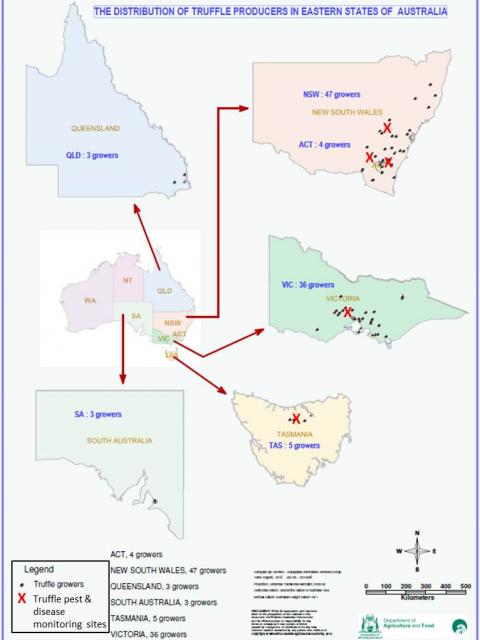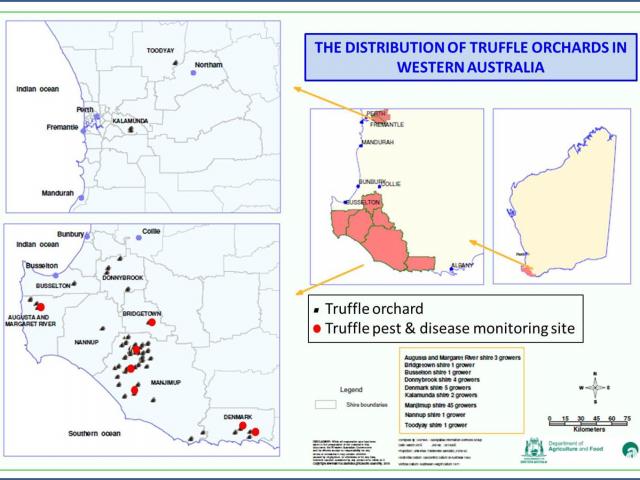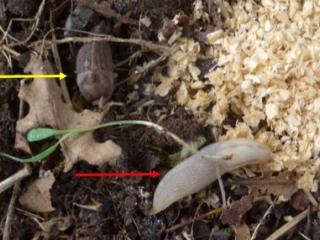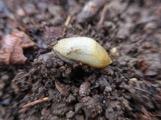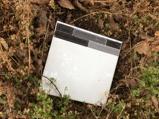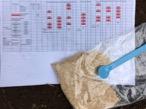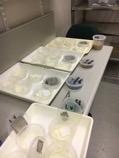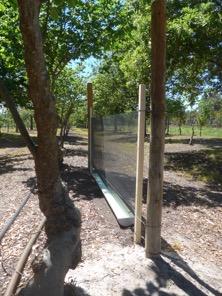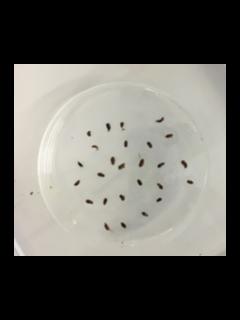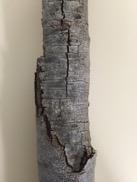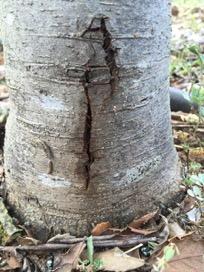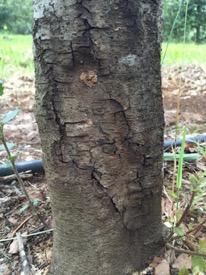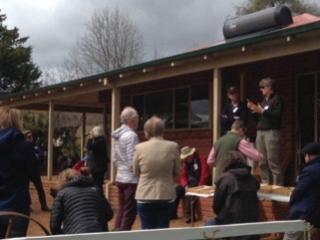Issue 3 - January 2017
Introduction
Pest and disease awareness and management in truffle orchards are relevant to both the establishment and ongoing maintenance of host trees and truffle production. Further, the yield and quality of the truffles are affected by invertebrate pests directly, and indirectly, through their contribution to truffle rot.
Identifying and cataloguing pests and diseases of truffles and their host trees

Identifying your pests and damage is now simple with MyPestGuide Reporter.
MyPestGuide is available online at MyPestGuide Reporter. Select ‘Truffle survey’ in the project drop-down box and follow the prompts.
MyPestGuide is also available as an app to carry with you when in the truffle orchard. Snap a picture and upload for the project team to investigate. Register to receive individual reports or just check all the shared reports. The app is available on both iOS and Android platforms.
National pest and disease survey - top pest species across the country
Thank you to all growers who participated in the national survey. As part of the rollout of results from the large database of information, here we provide a table that shows the top four pest issues by state.
Table 1 – Major pest problems observed by growers across Australia during the Pests and Diseases Survey conducted in December 2015 and throughout 2016.
| State | Growers | Trees* | Trees | Truffles^ | Truffles |
| ACT | 4 | Wingless grasshopper | Birds | - | - |
| NSW | 41 | Marsupials | Birds | Rot | Slugs |
| Queensland | 1 | Melolonthinae adults and larvae |
| - | - |
| South Australia | 3 | Rabbits | Snails | - | - |
| Tasmania | 4 | Marsupials | Snails | Slugs | Portuguese millipedes |
| Victoria | 32 | Snails | Marsupials | Slugs | Rot |
| Western Australia | 49 | African black beetle | Small pointed snail | Slugs | Rot |
*Powdery mildew was observed across Australia but has been omitted from the above table as its status as a significant disease is not clear at this point.
^Truffle pests were only recorded where numbers warranted.
Mapping & monitoring sites of Australian truffle orchards
After completing the national survey, the location of orchards of participating growers has been updated and these maps include the location of detailed monitoring sites associated with our project.
Field Activities
In the first year of the project, field activities concentrated on gathering information on the type of pests and diseases in orchards with some information on their abundance and pest status.
We have commenced field trials investigating the management of the key pests of truffles identified from the surveys – slugs and the truffle beetle, Thalycrodes mixtum, a native insect that is widely distributed across the wetter areas of southern Australia. We have called this beetle ‘truffle beetle TM’ to distinguish it from other truffle associated beetles recorded in Australia. For more on this beetle please see the Australian truffle orchards - integrated pest and disease management manual on the DAFWA website. The key pests (slugs and truffle beetle TM) were chosen based on results of the national grower survey and, for truffle beetle TM, information in WA from the 2016 truffle season.
Truffle damage study
During the 2016 truffle season we quantified damage to truffles in four truffle producing orchards in WA. For this, we examined 50 truffles each fortnight in each orchard. In three of the orchards, traps had been deployed to record fauna active in the truffle orchard. The truffles were examined in the field, then re-examined in the cleaning/grading room (Laboratory).
From this study, slug damage and pinholes possibly caused by truffle beetle TM were quantified.
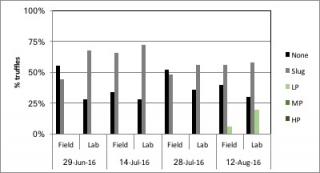
The results of paired field and laboratory examinations for two of these orchards are given in the figures. In orchard 1 (above) most damage to truffles was caused by slugs. Slug damage, unless very shallow, is removed from the truffle in the grading room and leads to loss for the grower.
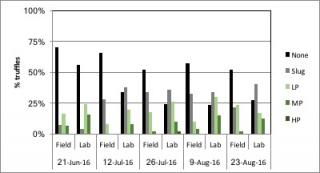
In orchard 2 (above) more damage was caused by truffle beetle TM than slugs. Also, the presence of pinholes requires removal of truffle pieces/slices until the end of the cavity is reached. This damage represents loss in terms of truffle waste and the time to prepare the truffle for sale in the grading room (Lab).
We also noted that field assessment of damage usually was an underestimate and in future will assess only in the grading room after truffles are brushed and washed.
Slugs
Five different slug species have been recorded in WA truffle orchards. The three most common species are shown here. Slugs appear to be a major pest of truffles, especially noted in Western Australia to date. Slugs are recognised as pests of truffles also in the US, Israel and South Africa.
The keeled slug (also known as the black keeled slug or the jet slug), Milax gagetes, appears widespread and is known as a pest of cereal crops also. The main distinguishing feature is a ridge or keel along the back. This slug is widespread across southern Australia. It can burrow in soil up to 20 centimetres.
The striped field slug (Lehmannia nyctelia) was accidentally introduced into Australia from Europe in the 1880s and is widespread across southern Australia. It is often seen after rainfall (or irrigation).
The hedgehog slug (Arion intermedius), also of European origin, is often present in high rainfall areas across Australia and has only recently been recorded in WA.
Investigations began by determining the best methods to attract slugs - comparing poultry pellets, trout pellets, yeast/sugar mix and flaky bran under vitreous bathroom tiles. The final trapping protocol for field experiments uses flaky bran under bathroom tiles.
Laboratory bioassays of the two most common slug species observed in WA truffle orchards were undertaken in November 2016.
Field trials are being conducted to compare to the results seen in the laboratory, and also to investigate the effectiveness of cultural controls – de-suckering hazelnut trees and litter removal from the orchard floor.
Truffle beetle TM
A flight intercept trap (FIT) in-situ, designed to intercept and capture flying insects.
The contents of the flight intercept traps were examined in the laboratory and the numbers of pest insects counted to monitor pest activity in different seasons
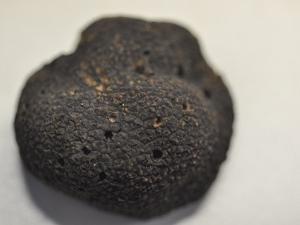
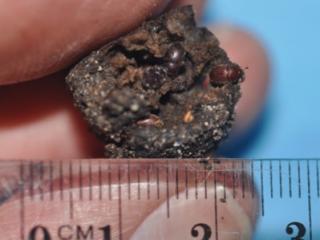
Truffle beetle TM emerged as a potentially problematic truffle pest in the 2016 harvest season in WA. The truffle beetle (Thalycrodes mixtum) has been recorded across Australia except the Northern Territory. At this stage all work is restricted to WA where one orchard suffered significant loss. Studies to date include evaluating the monitoring methods of flight intercept traps (FIT) and pitfall traps and a laboratory based bioassay. Investigations into the management of this pest continue. Further studies are planned to clarify the distribution and biology of the truffle beetle and to investigate management strategies to protect truffles.
Linking plant disease with truffle yield
Over the course of last two years we have identified a number of diseases present on Quercus ilex in Australia. Diseases of Q. ilex are relatively poorly studied; hence it is difficult to assess what threat a given disease would pose to the Australian truffle industry. One way is to investigate the effect of plant diseases on truffle yield is to assess the truffle yield of trees with varying degrees of infection (disease) - trees with different diseases, as well as those that are healthy. If the truffle yield of trees infected with a certain disease is not significantly different to that of healthy trees, it suggests that the particular disease does not pose a threat to the truffle industry (unless it causes tree mortality). We plan to assess a number of truffle orchards which have good truffle yield data to gain more information on severity of diseases present. Identifying which diseases cause the highest truffle yield losses will enable us to focus on those diseases for control/management options.
Additions to the Truffle pest & disease bulletin on tree diseases
Plant pathologist and project team member based at the Australian National University (ANU), Associate - Professor Celeste Linde, has significantly updated the online pest and diseases bulletin with respect to tree diseases. Of these updates we have included three examples of commonly seen symptoms, the details of which are available in the Australian truffle orchards - integrated pest and disease management manual.
BIOSECURITY
Our biosecurity article is included again for growers still developing this aspect of their farm management.
Good on-farm hygiene, or farm biosecurity as it is also known, is important for any agricultural venture. By being aware and following some key steps you can reduce the risk of unwanted insect, plant, animal and microbiological organisms entering your property and possibly causing problems. Poor on-farm hygiene can lead to:
- reduction of product quality
- reduction of yield
- contamination of product with inferior products
Good farm hygiene addresses the movement of vehicles and machinery, people and dogs. It is impractical to stop all pest and disease movement onto your property but you can minimise the risk. Foreign pests, diseases or contaminant fungi are most often brought into orchards in soil and plant material either intentionally introduced or by ‘hitching a ride’ on people, machinery and equipment and/or animals.
You can limit the people who enter the production area on your property to only those that need to enter. When they do enter it is particularly important that they have clean, dirt free, footwear. Having footbaths for cleaning and sanitising footwear at the entrance to the orchard is a good idea.
Likewise, all non-essential vehicles, machinery and equipment should be excluded from the orchard; and should be clean and free of dirt when it does enter. Having a wash down bay makes it easy for vehicles and machinery to be cleaned before entering the orchard, this is particularly important for vehicles that visit other properties such as contractors. Designated roadways can also reduce the amount of traffic into production areas.
Regular crop surveillance is always a good idea. It helps you pick up new pest and disease problems early keep on top of any ongoing pest and disease issues as well as track general tree health and management practices.
For detailed information on the DAFWA website refer to Truffle orchard on-farm hygiene.
For information on general farm biosecurity including a template for signage, refer to the Farm Biosecurity website.
2016 ATGA Conference and AGM, 9 – 11 September 2016, Manjimup, WA
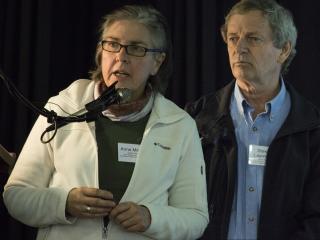
Members of the RIRDC Pest and Disease Project team presented project related information in a range of formats at the annual conference: Grower Workshops were conducted at the DAFWA facility on Friday and a summary of project activities was presented at the formal proceedings on Saturday. On the Sunday morning field walks were conducted in two producing orchards where participants were able to observe management processes and disease issues.
Project Support
We acknowledge the major funders for their support of the project:
Rural Industries Research and Development Corporation
Department of Agriculture and Food, Western Australia
Australian Truffle Growers Association
Truffle Producers of Western Australia
Australian National University
Department of Primary Industries of New South Wales
Truffle and Wine Company, Manjimup WA.
We also acknowledge the wonderful collaboration and assistance with this project provided by truffle growers and other personnel involved with the truffle industry across Australia.
The Department of Agriculture and Food, Western Australia is the lead agency in conducting this project and involves a team based in WA and eastern Australia. The project team is made up of Stewart Learmonth, Helen Collie, Alan Jacob and Alison Mathews of the Department of Agriculture and Food WA, consultant Alan Davey from Advyron RS Innovations, Janet Paterson and Paul Webb through the Truffle and Wine Co. Manjimup WA, Celeste Linde of the ANU, consultant Anne Mitchell of Manjimup Underground and Ainsley Seago of NSW DPI.
TO SEE WHAT THE MAJOR COMPONENTS OF THE PROJECT ARE, please refer to the previous newsletters:
If you’re interested in other truffle information produced by the Department of Agriculture and Food, Western Australia they have a web page on Cultivation of black truffles in Western Australia.
For any comments or questions in relation to the newsletter, please contact the project manager Stewart Learmonth: Ph (08) 9777 0167; 0417 959 139; stewart.learmonth@agric.wa.gov.au
Links to DAFWA truffle publications
Cultivation of black truffles in Western Australia
Truffle orchard on-farm hygiene
Australian truffle orchards - integrated pest and disease management

